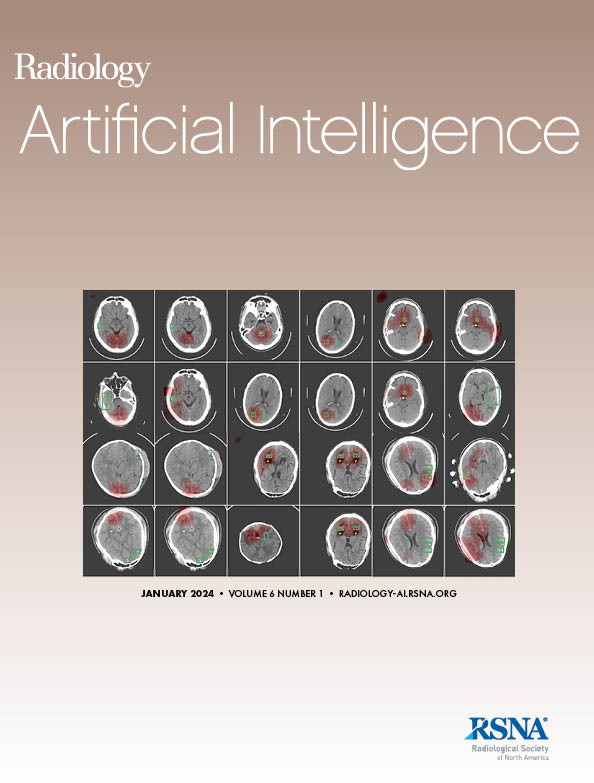Perry J Pickhardt, Thang Nguyen, Alberto A Perez, Peter M Graffy, Samuel Jang, Ronald M Summers, John W Garrett
下载PDF
{"title":"利用全自动深度学习工具改进基于 CT 的骨质疏松症评估。","authors":"Perry J Pickhardt, Thang Nguyen, Alberto A Perez, Peter M Graffy, Samuel Jang, Ronald M Summers, John W Garrett","doi":"10.1148/ryai.220042","DOIUrl":null,"url":null,"abstract":"<p><strong>Purpose: </strong>To develop, test, and validate a deep learning (DL) tool that improves upon a previous feature-based CT image processing bone mineral density (BMD) algorithm and compare it against the manual reference standard.</p><p><strong>Materials and methods: </strong>This single-center, retrospective, Health Insurance Portability and Accountability Act-compliant study included manual L1 trabecular Hounsfield unit measurements from abdominal CT scans in 11 035 patients (mean age, 58 years ± 12 [SD]; 6311 women) as the reference standard. Automated level selection and L1 trabecular region of interest (ROI) placement were then performed in this CT cohort with both a previously validated feature-based image processing tool and a new DL tool. Overall technical success rates and agreement with the manual reference standard were assessed.</p><p><strong>Results: </strong>The overall success rate of the DL tool in this heterogeneous patient cohort was significantly higher than that of the older image processing BMD algorithm (99.3% vs 89.4%, <i>P</i> < .001). Using this DL tool, the closest median Hounsfield unit values for single-, three-, and seven-slice vertebral ROIs were within 5% of the manual reference standard Hounsfield unit values in 35.1%, 56.9%, and 85.8% of scans; within 10% in 56.6%, 75.6%, and 92.9% of scans; and within 25% in 76.5%, 89.3%, and 97.1% of scans, respectively. Trade-offs in sensitivity and specificity for osteoporosis assessment were observed from the single-slice approach (sensitivity, 39.4%; specificity, 98.3%) to the minimum value of the multislice approach (for seven contiguous slices; sensitivity, 71.3% and specificity, 94.6%).</p><p><strong>Conclusion: </strong>The new DL BMD tool demonstrated a higher success rate than the older feature-based image processing tool, and its outputs can be targeted for higher specificity or sensitivity for osteoporosis assessment.<b>Keywords:</b> CT, CT-Quantitative, Abdomen/GI, Skeletal-Axial, Spine, Deep Learning, Machine Learning <i>Supplemental material is available for this article.</i> © RSNA, 2022.</p>","PeriodicalId":29787,"journal":{"name":"Radiology-Artificial Intelligence","volume":"4 5","pages":"e220042"},"PeriodicalIF":8.1000,"publicationDate":"2022-08-31","publicationTypes":"Journal Article","fieldsOfStudy":null,"isOpenAccess":false,"openAccessPdf":"https://www.ncbi.nlm.nih.gov/pmc/articles/PMC9530763/pdf/ryai.220042.pdf","citationCount":"0","resultStr":"{\"title\":\"Improved CT-based Osteoporosis Assessment with a Fully Automated Deep Learning Tool.\",\"authors\":\"Perry J Pickhardt, Thang Nguyen, Alberto A Perez, Peter M Graffy, Samuel Jang, Ronald M Summers, John W Garrett\",\"doi\":\"10.1148/ryai.220042\",\"DOIUrl\":null,\"url\":null,\"abstract\":\"<p><strong>Purpose: </strong>To develop, test, and validate a deep learning (DL) tool that improves upon a previous feature-based CT image processing bone mineral density (BMD) algorithm and compare it against the manual reference standard.</p><p><strong>Materials and methods: </strong>This single-center, retrospective, Health Insurance Portability and Accountability Act-compliant study included manual L1 trabecular Hounsfield unit measurements from abdominal CT scans in 11 035 patients (mean age, 58 years ± 12 [SD]; 6311 women) as the reference standard. Automated level selection and L1 trabecular region of interest (ROI) placement were then performed in this CT cohort with both a previously validated feature-based image processing tool and a new DL tool. Overall technical success rates and agreement with the manual reference standard were assessed.</p><p><strong>Results: </strong>The overall success rate of the DL tool in this heterogeneous patient cohort was significantly higher than that of the older image processing BMD algorithm (99.3% vs 89.4%, <i>P</i> < .001). Using this DL tool, the closest median Hounsfield unit values for single-, three-, and seven-slice vertebral ROIs were within 5% of the manual reference standard Hounsfield unit values in 35.1%, 56.9%, and 85.8% of scans; within 10% in 56.6%, 75.6%, and 92.9% of scans; and within 25% in 76.5%, 89.3%, and 97.1% of scans, respectively. Trade-offs in sensitivity and specificity for osteoporosis assessment were observed from the single-slice approach (sensitivity, 39.4%; specificity, 98.3%) to the minimum value of the multislice approach (for seven contiguous slices; sensitivity, 71.3% and specificity, 94.6%).</p><p><strong>Conclusion: </strong>The new DL BMD tool demonstrated a higher success rate than the older feature-based image processing tool, and its outputs can be targeted for higher specificity or sensitivity for osteoporosis assessment.<b>Keywords:</b> CT, CT-Quantitative, Abdomen/GI, Skeletal-Axial, Spine, Deep Learning, Machine Learning <i>Supplemental material is available for this article.</i> © RSNA, 2022.</p>\",\"PeriodicalId\":29787,\"journal\":{\"name\":\"Radiology-Artificial Intelligence\",\"volume\":\"4 5\",\"pages\":\"e220042\"},\"PeriodicalIF\":8.1000,\"publicationDate\":\"2022-08-31\",\"publicationTypes\":\"Journal Article\",\"fieldsOfStudy\":null,\"isOpenAccess\":false,\"openAccessPdf\":\"https://www.ncbi.nlm.nih.gov/pmc/articles/PMC9530763/pdf/ryai.220042.pdf\",\"citationCount\":\"0\",\"resultStr\":null,\"platform\":\"Semanticscholar\",\"paperid\":null,\"PeriodicalName\":\"Radiology-Artificial Intelligence\",\"FirstCategoryId\":\"1085\",\"ListUrlMain\":\"https://doi.org/10.1148/ryai.220042\",\"RegionNum\":0,\"RegionCategory\":null,\"ArticlePicture\":[],\"TitleCN\":null,\"AbstractTextCN\":null,\"PMCID\":null,\"EPubDate\":\"2022/9/1 0:00:00\",\"PubModel\":\"eCollection\",\"JCR\":\"Q1\",\"JCRName\":\"COMPUTER SCIENCE, ARTIFICIAL INTELLIGENCE\",\"Score\":null,\"Total\":0}","platform":"Semanticscholar","paperid":null,"PeriodicalName":"Radiology-Artificial Intelligence","FirstCategoryId":"1085","ListUrlMain":"https://doi.org/10.1148/ryai.220042","RegionNum":0,"RegionCategory":null,"ArticlePicture":[],"TitleCN":null,"AbstractTextCN":null,"PMCID":null,"EPubDate":"2022/9/1 0:00:00","PubModel":"eCollection","JCR":"Q1","JCRName":"COMPUTER SCIENCE, ARTIFICIAL INTELLIGENCE","Score":null,"Total":0}
引用次数: 0
引用
批量引用
Improved CT-based Osteoporosis Assessment with a Fully Automated Deep Learning Tool.
Purpose: To develop, test, and validate a deep learning (DL) tool that improves upon a previous feature-based CT image processing bone mineral density (BMD) algorithm and compare it against the manual reference standard.
Materials and methods: This single-center, retrospective, Health Insurance Portability and Accountability Act-compliant study included manual L1 trabecular Hounsfield unit measurements from abdominal CT scans in 11 035 patients (mean age, 58 years ± 12 [SD]; 6311 women) as the reference standard. Automated level selection and L1 trabecular region of interest (ROI) placement were then performed in this CT cohort with both a previously validated feature-based image processing tool and a new DL tool. Overall technical success rates and agreement with the manual reference standard were assessed.
Results: The overall success rate of the DL tool in this heterogeneous patient cohort was significantly higher than that of the older image processing BMD algorithm (99.3% vs 89.4%, P < .001). Using this DL tool, the closest median Hounsfield unit values for single-, three-, and seven-slice vertebral ROIs were within 5% of the manual reference standard Hounsfield unit values in 35.1%, 56.9%, and 85.8% of scans; within 10% in 56.6%, 75.6%, and 92.9% of scans; and within 25% in 76.5%, 89.3%, and 97.1% of scans, respectively. Trade-offs in sensitivity and specificity for osteoporosis assessment were observed from the single-slice approach (sensitivity, 39.4%; specificity, 98.3%) to the minimum value of the multislice approach (for seven contiguous slices; sensitivity, 71.3% and specificity, 94.6%).
Conclusion: The new DL BMD tool demonstrated a higher success rate than the older feature-based image processing tool, and its outputs can be targeted for higher specificity or sensitivity for osteoporosis assessment.Keywords: CT, CT-Quantitative, Abdomen/GI, Skeletal-Axial, Spine, Deep Learning, Machine Learning Supplemental material is available for this article. © RSNA, 2022.

 求助内容:
求助内容: 应助结果提醒方式:
应助结果提醒方式:


